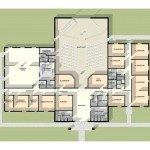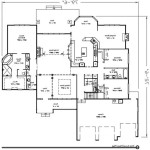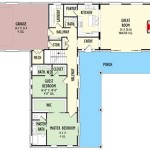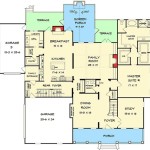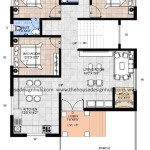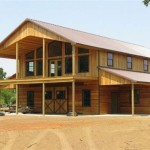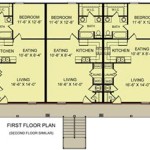Home Plans for Handicapped Living: Creating Accessible and Comfortable Spaces
Designing a home for individuals with disabilities requires careful consideration of accessibility, safety, and comfort. Home plans for handicapped living focus on creating spaces that are easy to navigate, use, and adapt to changing needs. With thoughtful planning, these homes can provide a high quality of life for their residents, allowing them to live independently and with dignity.
Key Considerations for Handicapped Living Home Plans
There are several core aspects to navigate when creating a home plan for handicapped living. These include:
1. Accessibility and Universal Design
Universal design principles are essential for creating homes that are accessible and usable by people of all abilities. This involves incorporating features that are adaptable to individual needs, such as:
- Wider doorways and hallways: Providing ample space for wheelchairs, walkers, and other mobility devices.
- Ramped entryways: Eliminating steps and providing alternative access for wheelchair users.
- Lower countertops and cabinets: Making kitchens and bathrooms accessible for individuals with limited reach.
- Grab bars in bathrooms: Enhancing safety and stability during bathing and showering.
- Lever-style door handles: Easier to operate than traditional knobs.
- Open floor plans: Providing a sense of spaciousness and easier navigation.
2. Safety and Security
Safety is paramount in a home for handicapped living. Features that promote safety include:
- Slip-resistant flooring: Reducing the risk of falls in wet areas like bathrooms.
- Non-slip rugs: Providing traction and preventing accidents.
- Well-lit hallways and stairs: Enhancing visibility and reducing the risk of tripping.
- Emergency call systems: Allowing residents to quickly summon help if needed.
- Secure locks and door handles: Providing peace of mind and increased safety.
- Fire alarms and smoke detectors: Ensuring early warning in case of emergencies.
3. Customization and Adaptability
Handicapped living home plans should be adaptable to future needs and changing levels of mobility. This can include:
- Open spaces for future modifications: Allowing for the installation of ramps, lifts, and other assistive devices.
- Flexible room layouts: Enabling adjustments to accommodate changes in mobility or the use of medical equipment.
- Accessible power outlets and switches: Ensuring easy access for individuals with limited reach.
- Adjustable furniture and appliances: Providing greater control and comfort.
- Smart home technology: Integrating systems for lighting, temperature control, and security, allowing for greater independence and control from any location.
Types of Home Plans for Handicapped Living
There are various types of home plans specifically designed for handicapped living, each catering to different needs and preferences.
1. Single-Story Homes
Single-story homes are particularly beneficial for individuals with mobility limitations, as they eliminate the need for stairs and promote easier navigation throughout the house. These plans often feature open floor plans, wider doorways, and accessible bathroom layouts.
2. Ranch-Style Homes
Ranch-style homes offer a similar layout to single-story homes, with a focus on spaciousness and ease of movement. They typically include a large living area, multiple bedrooms, and a well-designed kitchen and bathroom. They often have a covered patio, which can be a great addition to create a comfortable and accessible outdoor space.
3. Multi-Level Homes with Adaptive Features
For those who require a multi-level home, specific adaptations can be incorporated to make the house accessible. These may include ramps, lifts, and stairlifts. The design must prioritize safety and ease of movement, with ample space for maneuvering and accessibility for all levels.
Benefits of Home Plans for Handicapped Living
Designing a home specifically for handicapped living offers numerous benefits:
- Increased Independence: Accessible features promote self-sufficiency and reduce reliance on assistance from others.
- Enhanced Quality of Life: Creating a comfortable and functional environment can significantly improve the well-being of individuals with disabilities.
- Safety and Security: Built-in safety features minimize risks and provide peace of mind.
- Adaptability to Future Needs: The flexibility and adaptability of these designs can accommodate changing circumstances and evolving needs.
When creating a home plan for handicapped living, it is crucial to consult with professionals, including architects, designers, and accessibility specialists. Their expertise can ensure that the home meets specific needs, adheres to building codes, and is tailored to the individual's lifestyle and preferences.

Wheelchair Accessible Small House Plans Drummond

House Plans With Accessible Handicap

Wheelchair Accessible House Plan 2 Bedrms Baths 1687 Sq Ft 147 1009

Wheelchair Accessible Floor Plan

How To Make Your Home Wheelchair Accessible

How To Make Your Home Wheelchair Accessible

Rustic Wheelchair Accessible Shingle Cottage 681 Sq Ft 871006nst Architectural Designs House Plans

Wheelchair Accessible Small House Plans Drummond

Small Space Accessibility Accessible Homes

The Best Layouts For Handicap Accessible Homes Braulity

